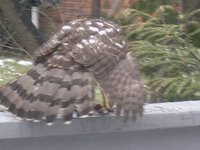

I was reading the Dec/Jan issue of Bookforum and came across a review of a nature book called _Stone: Imagination and the Loss of the Wild_. Some of the descriptions reminded me of a friend's recent encounter with a red-tailed hawk in his backyard. As he said: "It was *right there*." It seems the hawk was so absorbed in its task -- fluffing up its feather to hide and protect its prey -- he was able to get some pretty close-up photos. Here are two examples. You can sort of see the prey beneath his (hers?) magnificent claws. From what I know red-tails are fairly aggressive and fearless, but I am not totally sure about that.
But back to the book review: I sometimes really enjoy nature writing, but its rarely done well. In my 5-year stint working at Borders I shelved the nature and travel writing section for quite a while, so I read quite a bit in those genres. In my experience the books tend to be of two types: unduly sentimental (Annie Dillard when she's bad for example), or all-too-hilariously anecdotal (Tim Cahill, who is funny, but after a while it's like," ok, stop already; no one's travel/nature experiences are this funny). The author reviewed in the Bookforum piece, Ellen Meloy, sounds more tolerable than most. I liked the review's focus on her relationship to nature in terms of a visual/cognitive/imaginative relation. For example:
"You can spend a lot of time looking directly at a bighorn in the rocks before you actually see it. The temptation is to dilate on the moment of recognition, to somehow account for the enormous spiritual weight of that sudden presence. That is the modern nature writer's habitual posture -- waiting to exhale -- which is why, as Ellen once wrote, 'a great deal of nature writing sounds like a cross between a chloroform stupor and a high mass.' But the ram in the rocks is not so breathless. He is not struck by his own scarcity."
The reviewer, Verlyn Klinkenborg, describes Meloy's relationship to nature as hinging on the incommensurablity of this shift in perspective: the nature watcher is forced outward, only to encounter this indifference, what Klinkenborg calls a "monumental indifference."
The review ends with a quote from Meloy: "Sometimes the sheep are completely boring. Sometimes their animation moves me beyond words. Our 'companionship' closes the distance. I am here to learn something. I will need this knowledge. Time is running out."
This all reminds me that I must watch Herzog's movie "Grizzly Man" tonight, which a friend lent me some days ago. It's his documentary about a mentally unstable man who spent his life tracking and living in close proximity to , you guessed it, Grizzly bears. He eventually died a "grizzly"death in both senses of the term. Herzog's take on nature fascinates me. For him, it's fraught with danger and totally menacing. Nature writers should be forced to watch his documentary "My Best Fiend" -- which is mainly about his crazy relatonship with Klaus Kinsksi and the filming of "Fitzcarraldo and "Aguirre the Wrath of God," but has some great pronouncements about nature and filming in the Amazon. Herzog is so over the top. I love it.



1 comment:
Did you watch it? I just checked it out like two days ago. I really was interested in the way that Herzog made it not just a fascinating story about man + nature but also about filmmaking, a thematic strand that a lesser documentarian might have omitted.
Post a Comment